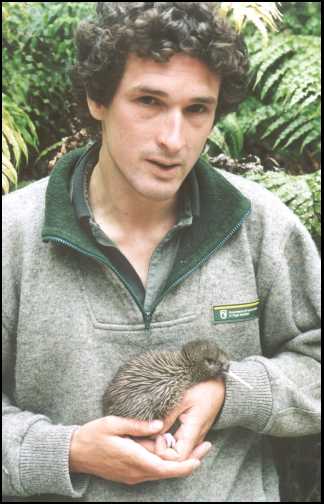Okarito Second Generation Kiwi Chick Hatched

Photo Caption: Chris Rickard with Dawn, the new generation kiwi from Okarito in South Westland
Department of Conservation media
release
19 January 2001
Okarito Second Generation Kiwi Chick Hatched
A new generation of kiwi has hatched in the Okarito kiwi reserve in South Westland amid plans to create the largest stoat control operation in the world.
A tiny chick named "Dawn" is being hailed as the new symbol of success for Operation Nest Egg in Okarito.

Closeup of Dawn
The two-week-old chick is the offspring of "Inka", the first Okarito Brown Kiwi egg artificially incubated by the Department of Conservation.
In 1997 Inka set the pattern when his egg was rescued from Okarito as part the Bank of New Zealand sponsored Kiwi Recovery Programme. He was hatched in Hokitika and placed on predator-free Motuara Island in the Marlborough Sounds until large enough to fight off stoats back on his home turf. Now Inka has made further history by entering fatherhood with the distinction of being the first captive bird to successfully pair up in the wild in Okarito.
Chris Rickard from DOC said the new chick was named Dawn to reflect the "dawning of a new era" for the threatened population of about 200 remaining Okarito Brown Kiwi, also called rowi.
"We're rapt... with thirty other rowi raised through the captive programme progressively coming up to breeding age at Okarito the future is looking very good, we have potentially got thirty birds that could be breeding in the next few years." Mr Rickard said.
"This is a big thing for people here in Franz. It is the first chick to be produced by a bird that was captive reared it is a real breakthrough and the start of a new generation."
Dawn is currently being readied for the trip to Motauroa Island, but may be one of the last chicks that has to make the lengthy road and sea journey.
This is because DOC's Franz Josef Waiau Area Office is preparing launch what is believed to be the largest stoat control programme attempted anywhere in the world. Using part of a $387,555 package allocated under the Government's biodiversity funding the massive operation will turn the 10km square reserve into a stoat-free-zone using more than 2000 traps housed in specially designed wooden tunnels to prevent accidental kiwi capture.
An initial contract was awarded this week that will see all the boxes placed on the reserve ready for trapping contractors to start work before the next breeding season begins in June. "If this is successful then Dawn will be the last of the chicks removed from Okarito," Mr Rickard said.
Meanwhile, Ivory, one of the first birds fitted with a transmitter tracking device in Okarito has died of natural causes.
Kiwi have a life expectancy of up to 40 years and it is thought Ivory was an ageing bird when her transmitter was first attached.
DOC staff have compiled significant amounts of useful information on rowi since monitoring began in 1992.
The Government's biodiversity funding has allowed monitoring at Okarito to double.
For further information phone Chris Rickard
03 752-0796 or Ian Gill 03 755-4013ah


 Royal NZ Ballet: RNZB's Tutus On Tour Returns For Summer 2025
Royal NZ Ballet: RNZB's Tutus On Tour Returns For Summer 2025 Little Miracles Trust: The Little Miracles Trust World Prematurity Day Campaign
Little Miracles Trust: The Little Miracles Trust World Prematurity Day Campaign NZ Society for the Study of Diabetes: Critical Workforce Shortages Leave People With Type 1 Diabetes Unable To Access Life Changing Technology
NZ Society for the Study of Diabetes: Critical Workforce Shortages Leave People With Type 1 Diabetes Unable To Access Life Changing Technology Kindergartens Aotearoa: Kindergartens Aotearoa Opposes Lower Standards For Homebased Services
Kindergartens Aotearoa: Kindergartens Aotearoa Opposes Lower Standards For Homebased Services Universities New Zealand - Te Pokai Tara: Three Outstanding Aotearoa New Zealand Students Awarded Rhodes Scholarships
Universities New Zealand - Te Pokai Tara: Three Outstanding Aotearoa New Zealand Students Awarded Rhodes Scholarships University of Auckland: 800 Mathematicians Set To Converge On Auckland
University of Auckland: 800 Mathematicians Set To Converge On Auckland